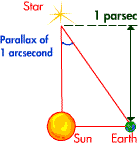Parsecs
Created | Updated Feb 12, 2010

A parsec is not just a word Spock uses to sound clever, it is a unit of distance. The name is derived from two terms: parallax and arcsecond. It is the distance an object is from the Earth if its parallax is one arcsecond. Of course, this may have very little meaning to anyone who is not an astrophysicist, but we will attempt to explain.
Parallax
Hold a finger up in front of you and look at it with one eye, closing the other eye. Now swap eyes. As you can see, the position of your finger has moved relative to its background. Trigonometry can determine from the point half-way between your eyes and the point halfway between the observed positions of your finger, what the angle would be if either viewpoint formed a triangle. This would be its parallax.
In measurement of stellar parallax, the left and right eyes are observations of a star from Earth six months apart, taken from either side of the Sun. Stars which are close to the Earth will appear to have moved relative to the background consisting of all the other stars. The angle that the star appears to have moved by is divided by two to give the star's parallax.
Arcsecond?
Most of us know that angles are measured in degrees, and there are 360 degrees in a circle. For more precise work, a degree is divided into 60 minutes. These are usually called arcminutes to distinguish them from normal minutes, because they measure the extent of an arc. For even more precise measurements, an arcminute is divided into 60 arcseconds. An arcsecond represents 1/60th of an arcminute, which itself represents 1/60th of a degree, a degree being 1/360th of the circle of the whole sky. Thus an arcsecond represents 1/1,296,000th of the circle.
How Big is a Parsec?
A parsec is equal to 3.086x1016 metres, 3.26 light-years, or 206,265 Astronomical Units. In other words, quite a long way. Here's an idea of roughly how far:
The distance to the closest star to our Sun, Proxima Centauri, is about 1 parsec.
The distance to the centre of our galaxy is about 8,000 parsecs.
The distance to the Andromeda galaxy is about 1 million parsecs1.
The distance across the entire universe is thought to be several billion parsecs2.

